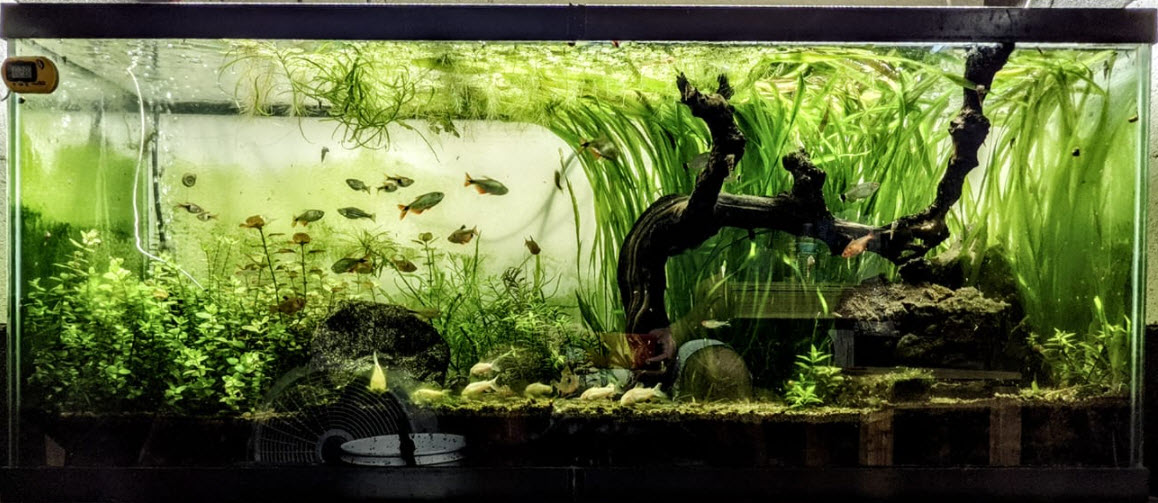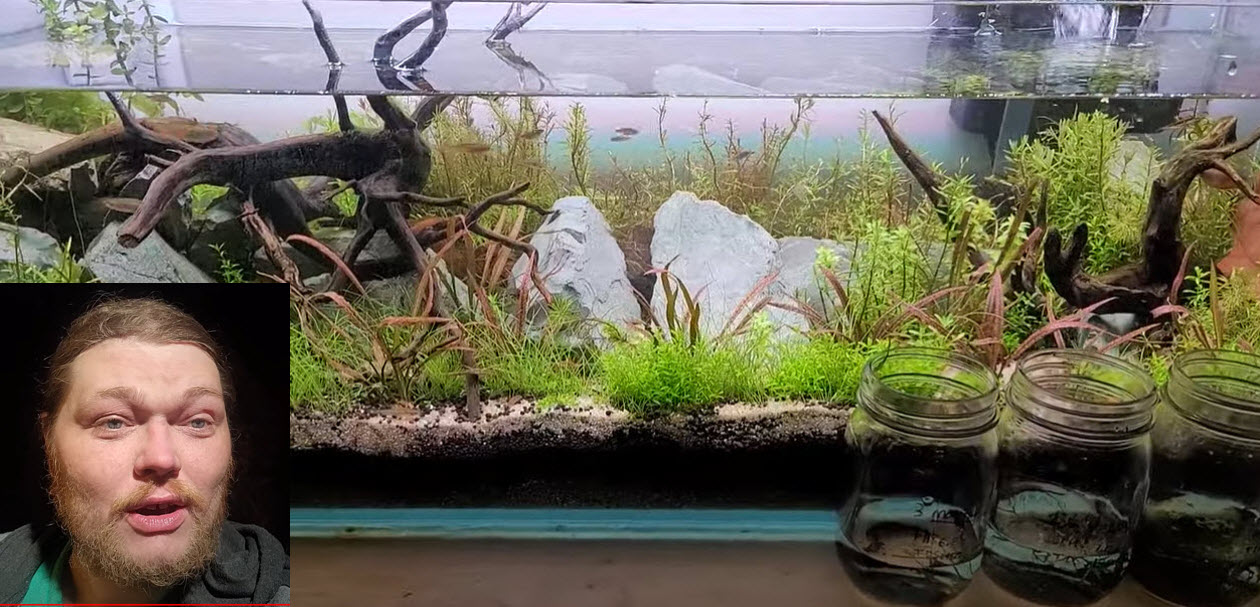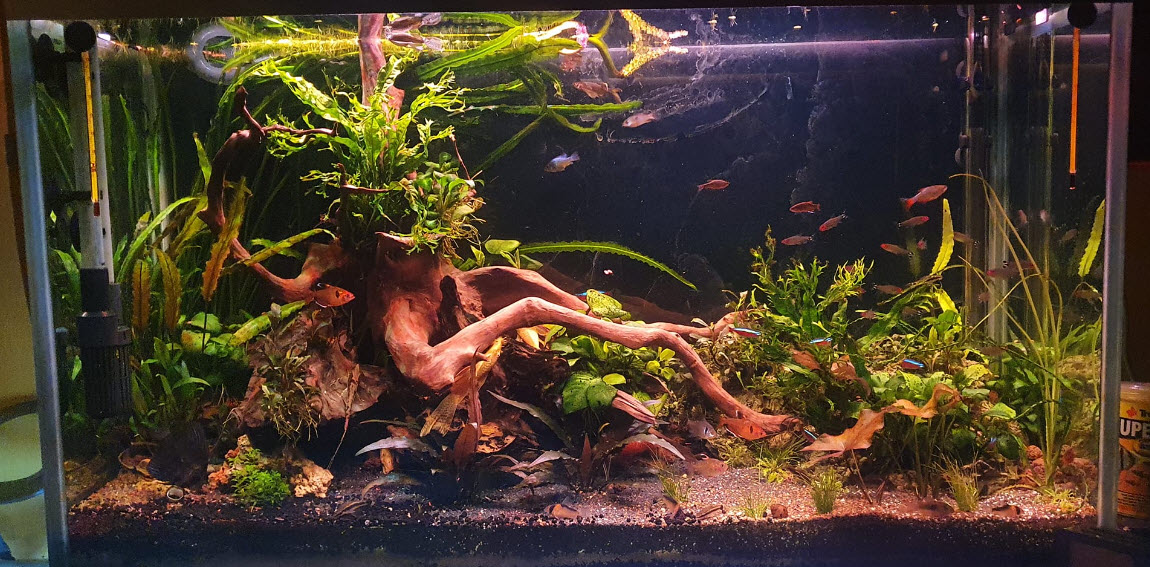
A Caveat
ALL “natural” approaches I’ve seen have one problem. They all have a yellow tint to the water. And neither Purigen or activated carbon remove this slight yellow tinge. Most people don’t seem to even notice it. But I do and it bothers me. And those approaches to a “natural” all tend to give dull or even murky water IF the filtration is low. Again, some people don’t like murky water, including myself.
The “Natural” Approach #1
One interesting approach to planted aquariums is the “natural” approach. It attempts to duplicate a farm pond in an aquarium. This type of aquarium has become the latest “rage” to hit the hobby. This “natural aquarium” can be defined by the following characteristics:
- Heavily planted with lots of easy “green” plants
- A few very small fish, snails and/or shrimp
- No filter
- No air stone
- No water changes.
- Very light feeding
- No fertilization
- Various substrates
- Plants are trimmed or harvested regularly
There are several YouTube presenters which have done “Natural” aquarium set-ups which meet the criteria above. These presenters include LRB Aquatics, Flip Aquatics and MD Fish Tanks. There are also a bunch of presenters which have done small “natural” “nano” tanks.

The excellent YouTube channel “The Secret History Living in Your Aquarium” (Alexander Williamson) has several “natural” aquariums with huge amounts of plants, a few fish, and no filtration. He says he has done no water changes for years in these “natural” aquariums.
Some of Mr. Williamson’s aquariums use “deep bed” substrates while others do not. Most of his tanks are “soiled” or “Walstad” tanks. Most of his tanks are overgrown with both submerged and emergent vegetation. All his tanks are inoculated with pond mud. Mr. Williamson has some small fish in these aquariums, typically with overgrowths of plants. When he feeds the fish he is adding nitrates and phosphates to the aquarium, which feed the plants.
There is no aeration and no water movement in these aquariums. Mr. Williamson does trim the plants and removes the trimmings. When he does that he is removing nitrates and phosphates from the aquariums.

Mr. Williamson makes the point that these aquariums are somewhat “touchy” and cannot take much in the way of overfeeding or fish dying. If one is interested in this type of “natural” aquarium go to the “The Secret History Living in Your Aquarium” YouTube channel and browse.
This type of “natural” aquarium, without filtration, is VERY difficult to do in an aquarium and kudos to Mr. Williamson for having accomplished it with some VERY attractive aquariums. I admit I’ve tried many times to get the “natural” aquarium and failed miserably every time. So I have some appreciation of how difficult it is. Note that it is a REQUIREMENT with this type of aquarium to only have a few small fish and very light feeding.

Other Types of “Natural” Aquariums
Everyone has a different definition of what constitutes a “natural” aquarium. Some define it ONLY to describe an aquarium that meets the above criteria. I happen to be one of those who ascribe to that definition. Others define it simply as one of the many forms of low tech planted aquariums where there is no carbon dioxide injection and no fertilization by chemical fertilizers. Still others define it as a “mature” aquarium which has been inoculated with pond mud and the like.
Be that as it may, here are some other aquariums that are called “natural” by those who use them.

Walstad “Natural Aquariums”
There is a type of “natural” aquarium which differs from the above. This is the Walstad soiled aquarium. This can be defined by the following characteristics:
- Heavily planted with lots of easy “green” plants
A few very small fish and/or shrimpSome small FishNo filterLimited Filtration- No air stone
No water changes.Small Water ChangesVery light feedingOver FeedingNo fertilizationFertilization from excess foodVarious substratesOne inch cellulose rich soil under one inch gravel
We cover that aquarium form in this article:
15.8. Walstad Aquarium

Father Fish “Natural” Aquariums
Another system that uses a filtered “natural” planted system with some air stone aeration can be perused in the popular YouTube channel “Father Fish”, Lou Foxwell (great YouTube channel, even if, like all of us “older” folks, he tends to ramble on a bit). The system he uses is somewhat different than most low-tech planted approaches and radically different than the high-tech planted approaches. The system he uses can be summarized as follows:
- Heavily planted with lots of easy “green” plants
A few very small fish and/or shrimpLight stocking of medium sized fishNo filter“Deep substrate”, “detritus” and plant filtrationNo air stoneSmall air stone or no air stoneNo water changesWater changes ONLY “when needed” (depends on plant density)- Very light feeding
No fertilizationFertilization only from food and compost substrateVarious substratesRich compost under three inches of sand
Father Fish has some very healthy fish and some very healthy plants so his methods work. Most of Father Fish’s tank have yellow, slightly murky water (he admits this in several of his videos!) so I’m not a big fan as I like crystal clear water.
More about Father Fish’s Aquariums can be found at this link:
15.17. Father Fish Aquariums

Dan Hiteshew Aquarium
Dan Hiteshew on his site “Everyday Fishkeeping” (good YouTube channel) has some fish tanks using what he calls a “natural” approach.
The system he uses can be summarized as follows:
- Heavily planted with lots of easy “green” plants
A few very small fish and/or shrimpModerate number of fishNo filterLimited “Detritus” and Plant Filtration with small filter with poor mediaNo air stoneSmall Air StoneNo water changes.Sizable Water ChangesVery light feedingDecent FeedingNo fertilizationFertilization only from foodVarious substratesDeep gravel substrate

Dan Hiteshew espouses aquarium filtration by something he calls a “deep gravel filter”. It is simply a three to five inch deep bed of aquarium gravel. This gravel bed will accumulate a thick layer of brown gunk in the spaces between the gravel stones. This brown gunk can accumulate sizable amounts of nitrate in its structure as “assimilatory denitrification”. And it can foster a good growth of easy to grow “green” plants.
This 125 does have a Sunsun 304B filter loaded with bioballs and ceramic rings on it. But this is very poor biofiltration for this stocking of a 125 aquarium (Dan admits it is poor filtration). Dan uses inoculate from ponds and thus this aquarium is very “mature”. Note the green Java fern and anubias pictured in Dan’s tank above will grow anywhere.

This all shows that there are MANY ways to be successful at keeping aquariums.
For both the Father Fish and the Dan Hiteshew methods I would add a ton of filtration to the mix. Something along the lines of a large canister filled with foam, pot scrubbers or K1. Or a sump. And I would baffle the outlet of the filter to minimize the surface agitation in the aquarium. I’m just a huge believer in over filtration in ANY and ALL tanks. Note that filtration is a NATURAL process that occurs in all ponds and streams. So an aquarium with a filter is not “unnatural”.

“Balanced” Aquariums
Note that some try to come up with “balanced biotopes” aquariums (sometimes called a “balanced ecosphere” or “enclosed ecosystem”) where there is no inputs other than light (i.e. no food or air) and no outputs (i.e. no plant trimmings). There are a few small fish, shrimp or snails in such a “balanced biotope” aquarium. The whole “balanced biotope” is sealed tight and placed in light shade. In theory the “balance” goes as follows:
- Animals eat the plants and breath the oxygen
- Animals excrete plant nutrients and carbon dioxide
- Plants “eat” the nutrients, carbon dioxide and light
- Plants excrete oxygen
- Animals eat the plants and breath the oxygen
- etc.
These aquariums almost always end up as cloudy, unattractive beds of green algae with MAYBE a few living crustaceans or snails. I’ve never run across a truly successful version of this extreme version of a “natural” fish aquarium. There are some nano tanks on YouTube that do this with shrimp or snails but none have fish. And all the ones I could find have cloudy, unattractive water and glass covered in algae.
.
Return to Planted Tank Menu
.
Aquarium Science Website
The chapters shown below or on the right side in maroon lead to close to 400 articles on all aspects of keeping a freshwater aquarium. These articles have NO links to profit making sites and are thus unbiased in their recommendations, unlike all the for-profit sites you will find with Google. Bookmark and browse!

B z says
I have a nano 1 foot by half foot tank with guppies, ramshorn and rabbit snails, and 1 indostomus paradoxus that is very good at hiding. The substrate is just 1 inch of calcined clay, sand, gravel, ceramic (basically just leftovers from my main tanks thrown together). Planted with easy greens, no filter, a tiny air stone, and it gets the full morning sun, water never changed. No feeding at all. It’s half a year old and doing very well. I set it up originally to breed feeder snails, and also as a place for plant trimmings to grow roots before I replanted them. Later I added a bunch of guppy fry on a lark, and theyre on their second or third generation now.
Come to think of it, this is eerily like a Father Fish aquarium, except that the snail castings take the place of his organic underlayer. There is very little algae despite the 12 hours of sunlight it gets (4 to 5 in direct sun!), and no algae on plant leaves at all. The water has “turned blackwater” but thats to be expected with my local water.
I also THINK their castings provide a lot of co2, in the sense that my air driven UGF tanks all have amazing plant growth despite the aeration. But I guess there’s no way to test if that’s due to co2, the nutrient content, or simply because they do such a great job at eating algae…
But snails man, they’re the secret ingredient. They deserve a better rep.
Dave says
In Reply to Ben Z …. There are two types of “Bio-orbs”. A standard Round “Bio-Orb” aquarium with an air stone is just like any other aquarium. It is just round. Then there is the “enclosed ecosystem” “bio-orbs” which are never opened once sealed. After a few months the “enclosed ecosystem” is an unsightly mass of detritus and algae with MAYBE some alive crustaceans in it. Hardly a decorative aquarium.
Ben z says
Regarding balanced aquariums… there are bio-orbs in science museums that say the enclosed ecosystem can last years. Assuming that’s true… what r the professionals doing differently, in your opinion?